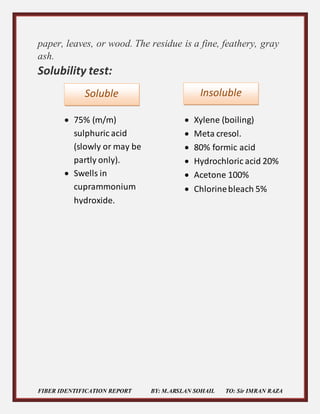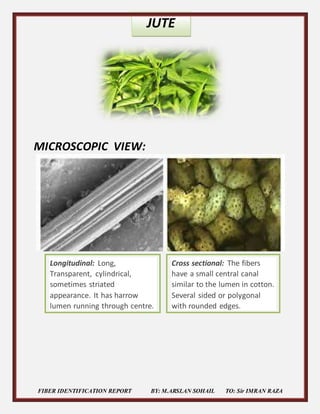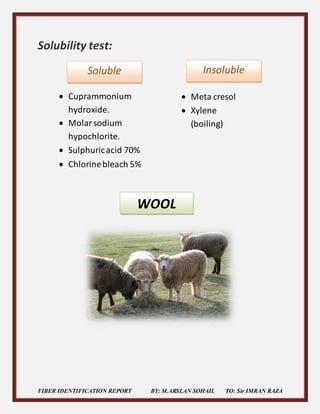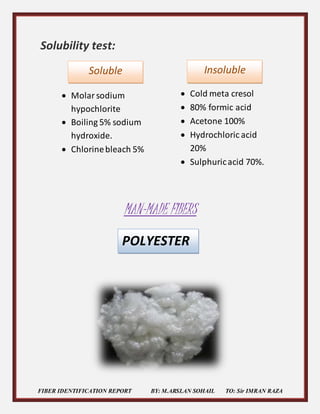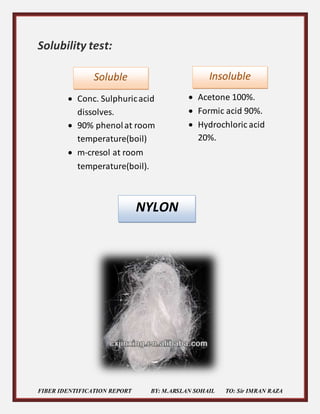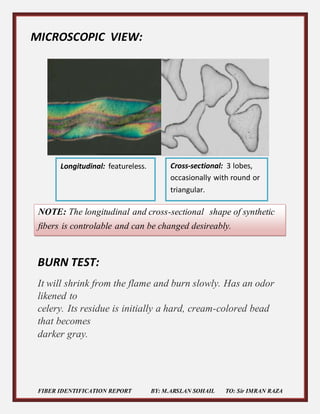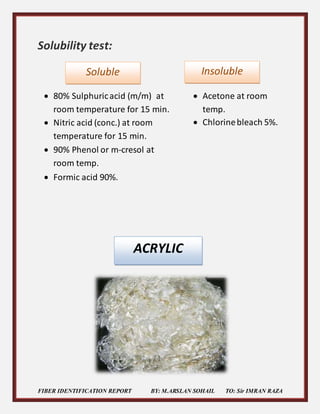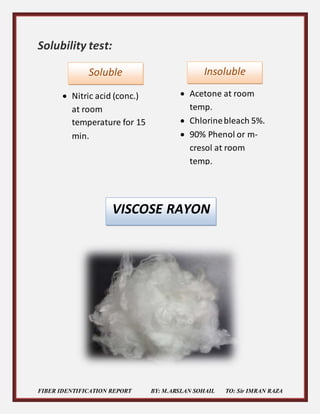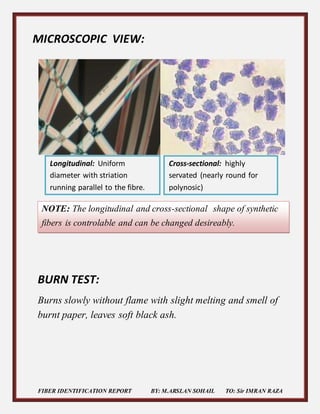Identification of Textile Fibers
- 1. FIBER IDENTIFICATION REPORT BY: M.ARSLAN SOHAIL TO: Sir IMRAN RAZA FIBER IDENTIFICATION REPORT NATURAL FIBERS BURN TEST: COTTON MICROSCOPIC VIEW: Longitudinal: Ribbon shaped with periodic twists called convolutions. Cross sectional: Collapsed tube or bean shaped.
- 2. FIBER IDENTIFICATION REPORT BY: M.ARSLAN SOHAIL TO: Sir IMRAN RAZA Ignites on contact with flames; burns quickly and leaves a yellowish to orange afterglow when put out. Does not melt. It has the odor of burning paper, leaves, or wood. The residue is a fine, feathery, gray ash. Solubility test: Soluble Insoluble ’éĘ 70% sulphuric acid ( 20 min) ’éĘ Cuprammoniumhydroxide ’éĘ 80% formic acid ’éĘ Xylene (boiling) ’éĘ Hydrochloric acid 20% ’éĘ Acetone 100% ’éĘ Chlorinebleach 5% ’éĘ
- 3. FIBER IDENTIFICATION REPORT BY: M.ARSLAN SOHAIL TO: Sir IMRAN RAZA BURN TEST: . Does not melt. It has the odor of burning FLAX/ LINEN MICROSCOPIC VIEW: Longitudinal: Bamboo- like with cross wise markings called nodes. Cross-sectional: The cell wall appears thick and polygonal in shape with lumen in the centre.
- 4. FIBER IDENTIFICATION REPORT BY: M.ARSLAN SOHAIL TO: Sir IMRAN RAZA paper, leaves, or wood. The residue is a fine, feathery, gray ash. Solubility test: Soluble Insoluble ’éĘ 75% (m/m) sulphuric acid (slowly or may be partly only). ’éĘ Swells in cuprammonium hydroxide. ’éĘ Xylene (boiling) ’éĘ Meta cresol. ’éĘ 80% formic acid ’éĘ Hydrochloric acid 20% ’éĘ Acetone 100% ’éĘ Chlorinebleach 5%
- 5. FIBER IDENTIFICATION REPORT BY: M.ARSLAN SOHAIL TO: Sir IMRAN RAZA JUTE MICROSCOPIC VIEW: Cross sectional: The fibers have a small central canal similar to the lumen in cotton. Several sided or polygonal with rounded edges. Longitudinal: Long, Transparent, cylindrical, sometimes striated appearance. It has harrow lumen running through centre.
- 6. FIBER IDENTIFICATION REPORT BY: M.ARSLAN SOHAIL TO: Sir IMRAN RAZA BURN TEST: It does not shrink from flame. It smells like burning leaves or wood. The ash is gray and smoke has no fume hazard. Solubility test: Soluble Insoluble ’éĘ 75% (m/m) sulphuricacid (slowly or may be partly only). ’éĘ Swells in cuprammonium hydroxide. ’éĘ Xylene (boiling) ’éĘ Meta cresol. SILK
- 7. FIBER IDENTIFICATION REPORT BY: M.ARSLAN SOHAIL TO: Sir IMRAN RAZA MICROSCOPIC VIEW: BURN TEST: Burns slowly, but does not melt. It shrinks from the flame. It has the odor of charred meat (some say like burned hair). The residue is a black, hollow irregular bead that can be easily to a gritty, grayish- black ash powder. It is self-extinguishing, i.e., it burns itself out. Longitudinal: like a hollow glass rod. Cross sectional: Triangular with rounded corners, in pairs.
- 8. FIBER IDENTIFICATION REPORT BY: M.ARSLAN SOHAIL TO: Sir IMRAN RAZA Solubility test: Soluble Insoluble ’éĘ Cuprammonium hydroxide. ’éĘ Molarsodium hypochlorite. ’éĘ Sulphuricacid 70% ’éĘ Chlorinebleach 5% ’éĘ Meta cresol ’éĘ Xylene (boiling) ’éĘ Acetone 100% WOOL
- 9. FIBER IDENTIFICATION REPORT BY: M.ARSLAN SOHAIL TO: Sir IMRAN RAZA BURN TEST: Burns with an orange sputtery color, but does not melt. It shrinks from the flame. It has a strong odor of burning hair or feathers. The residue is a black, hollow irregular bead that can be easily crushed into a gritty black powder. It is self-extinguishing, i.e., it burns itself out. MICROSCOPIC VIEW: Longitudinal: Irregular and roughly cylindrical, prominent scale marking or flattened plates. Cross sectional: Oval to circular with variation in diameter medulla is concentric and variable in size.
- 10. FIBER IDENTIFICATION REPORT BY: M.ARSLAN SOHAIL TO: Sir IMRAN RAZA Solubility test: MAN-MADE FIBERS Soluble Insoluble ’éĘ Molarsodium hypochlorite ’éĘ Boiling 5% sodium hydroxide. ’éĘ Chlorinebleach 5% ’éĘ Cold meta cresol ’éĘ 80% formic acid ’éĘ Acetone 100% ’éĘ Hydrochloric acid 20% ’éĘ Sulphuricacid 70%. POLYESTER
- 11. FIBER IDENTIFICATION REPORT BY: M.ARSLAN SOHAIL TO: Sir IMRAN RAZA BURN TEST: It will shrink from the flame and burn slowly giving off black smoke. Has a somewhat sweet chemical odor. The residue is initially a hard cream-colored bead that becomes darker tan. MICROSCOPIC VIEW: Longitudinal: Very regular,smooth, rod like appearance. Cross sectional: Circular in cross section. NOTE: The longitudinal and cross-sectional shape of synthetic fibers is controlable and can be changed desireably.
- 12. FIBER IDENTIFICATION REPORT BY: M.ARSLAN SOHAIL TO: Sir IMRAN RAZA Solubility test: Soluble Insoluble ’éĘ Conc. Sulphuricacid dissolves. ’éĘ 90% phenolat room temperature(boil) ’éĘ m-cresol at room temperature(boil). ’éĘ Acetone 100%. ’éĘ Formic acid 90%. ’éĘ Hydrochloric acid 20%. NYLON
- 13. FIBER IDENTIFICATION REPORT BY: M.ARSLAN SOHAIL TO: Sir IMRAN RAZA BURN TEST: It will shrink from the flame and burn slowly. Has an odor likened to celery. Its residue is initially a hard, cream-colored bead that becomes darker gray. MICROSCOPIC VIEW: Longitudinal: featureless. Cross-sectional: 3 lobes, occasionally with round or triangular. NOTE: The longitudinal and cross-sectional shape of synthetic fibers is controlable and can be changed desireably.
- 14. FIBER IDENTIFICATION REPORT BY: M.ARSLAN SOHAIL TO: Sir IMRAN RAZA Solubility test: Soluble Insoluble ’éĘ 80% Sulphuricacid (m/m) at room temperature for 15 min. ’éĘ Nitric acid (conc.) at room temperature for 15 min. ’éĘ 90% Phenol or m-cresol at room temp. ’éĘ Formic acid 90%. ’éĘ Acetone at room temp. ’éĘ Chlorinebleach 5%. ACRYLIC
- 15. FIBER IDENTIFICATION REPORT BY: M.ARSLAN SOHAIL TO: Sir IMRAN RAZA BURN TEST: Flames and burns rapidly with hot, sputtering flame and a black smoke. Has an acrid, fishy odor. The residue is a hard irregularly-shaped black bead. MICROSCOPIC VIEW: Longitudinal: Rod like with smooth surface and profile. Cross-sectional: Nearly round or bean shaped NOTE: The longitudinal and cross-sectional shape of synthetic fibers is controlable and can be changed desireably.
- 16. FIBER IDENTIFICATION REPORT BY: M.ARSLAN SOHAIL TO: Sir IMRAN RAZA Solubility test: Soluble Insoluble ’éĘ Nitric acid (conc.) at room temperature for 15 min. ’éĘ Acetone at room temp. ’éĘ Chlorinebleach 5%. ’éĘ 90% Phenol or m- cresol at room temp. VISCOSE RAYON
- 17. FIBER IDENTIFICATION REPORT BY: M.ARSLAN SOHAIL TO: Sir IMRAN RAZA BURN TEST: Burns slowly without flame with slight melting and smell of burnt paper, leaves soft black ash. MICROSCOPIC VIEW: Longitudinal: Uniform diameter with striation running parallel to the fibre. Cross-sectional: highly servated (nearly round for polynosic) NOTE: The longitudinal and cross-sectional shape of synthetic fibers is controlable and can be changed desireably.
- 18. FIBER IDENTIFICATION REPORT BY: M.ARSLAN SOHAIL TO: Sir IMRAN RAZA Solubility test: Soluble Insoluble ’éĘ 80% Sulphuricacid (m/m) at room temperature for 15 min. ’éĘ Nitric acid (conc.) at room temperature for 15 min. ’éĘ Acetone at room temp. ’éĘ Chlorinebleach 5%. ’éĘ 90% Phenol or m-cresol at room temp. ’éĘ Formic acid 90%. ’éĘ




